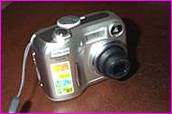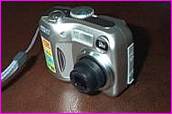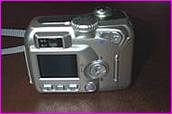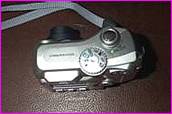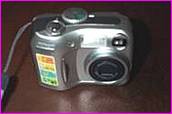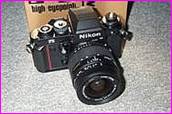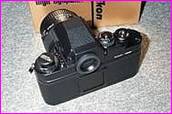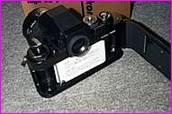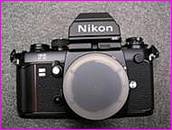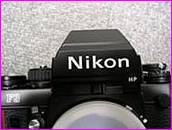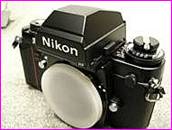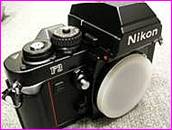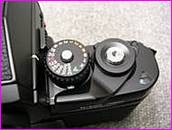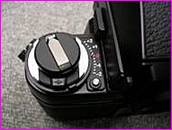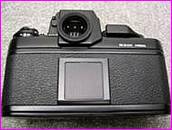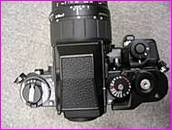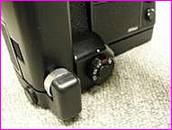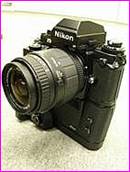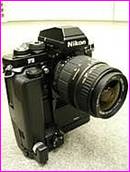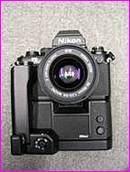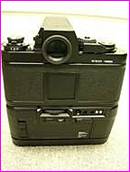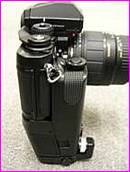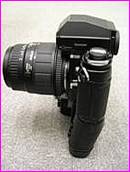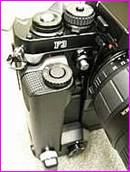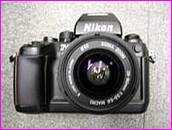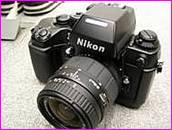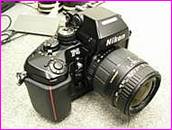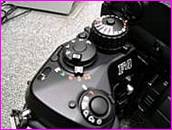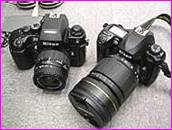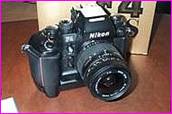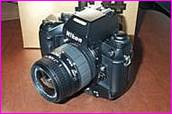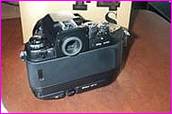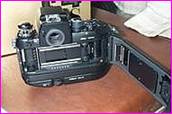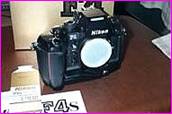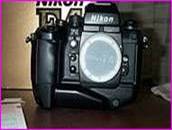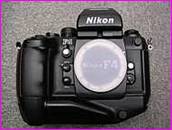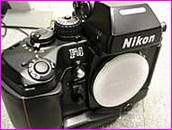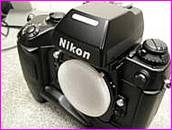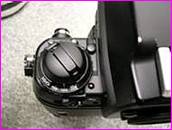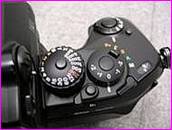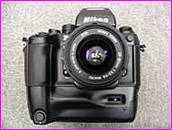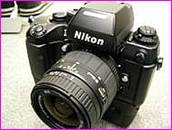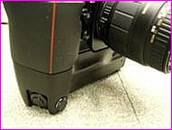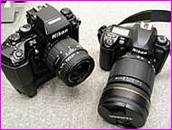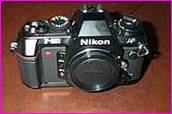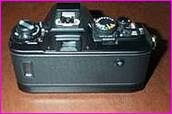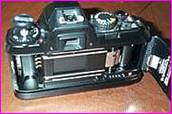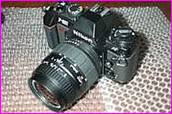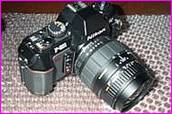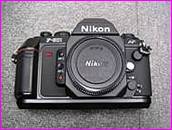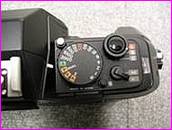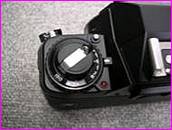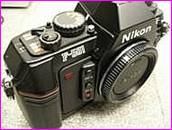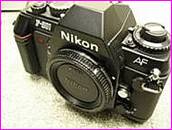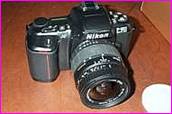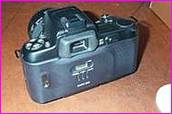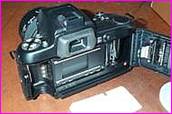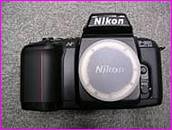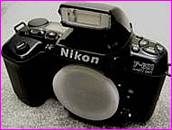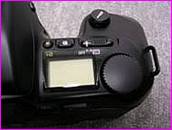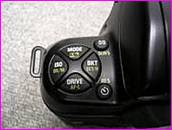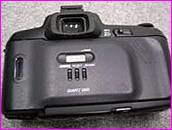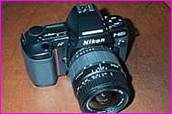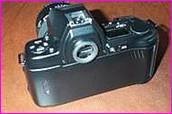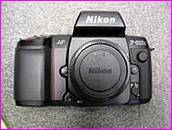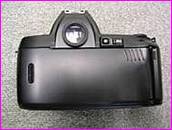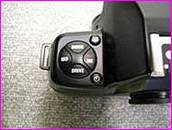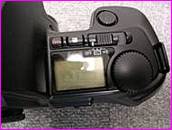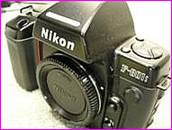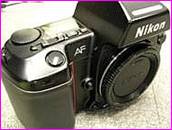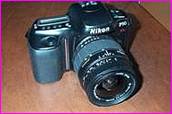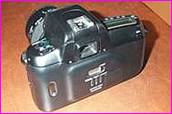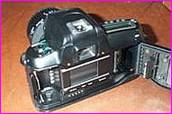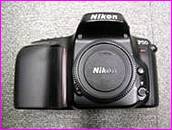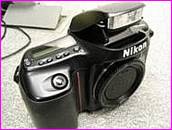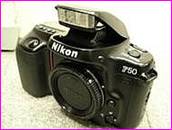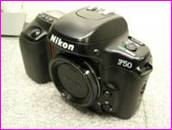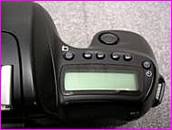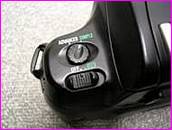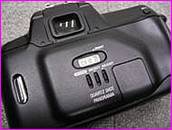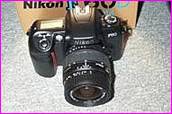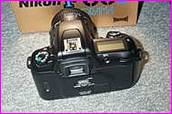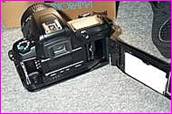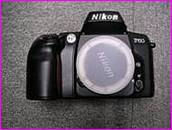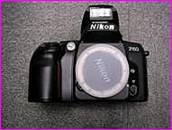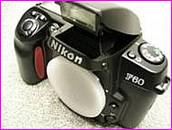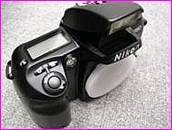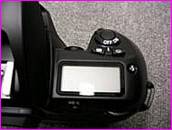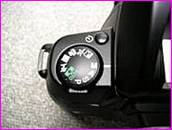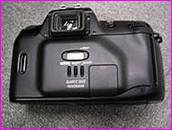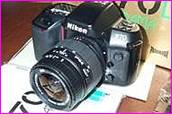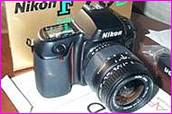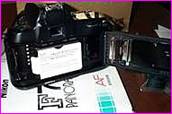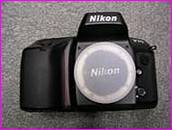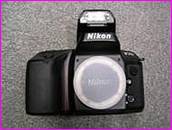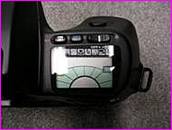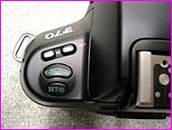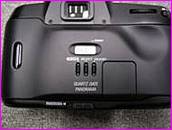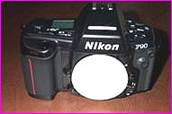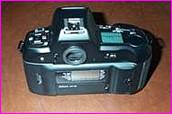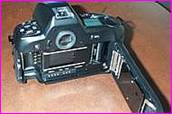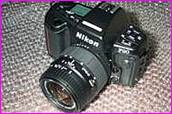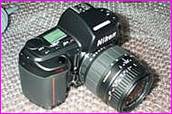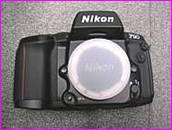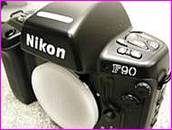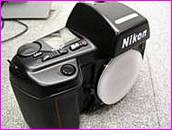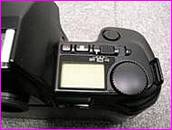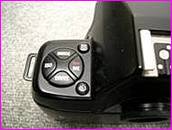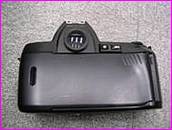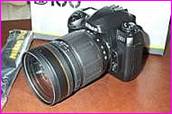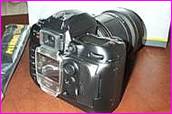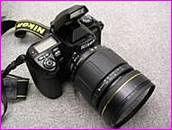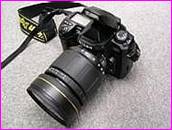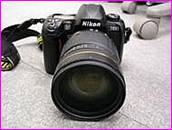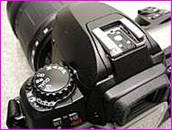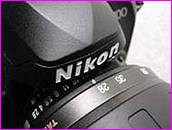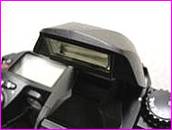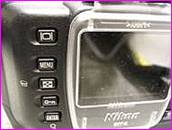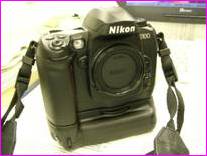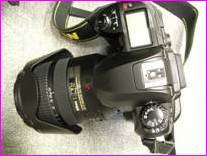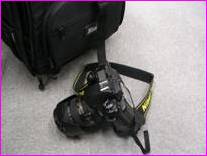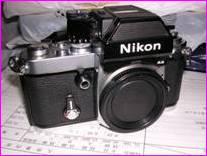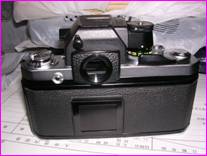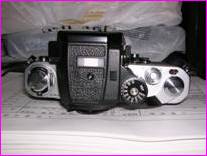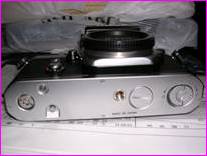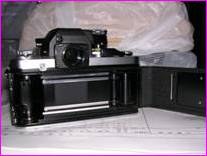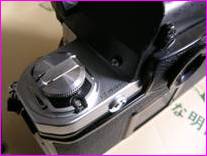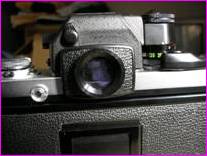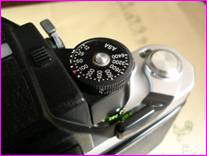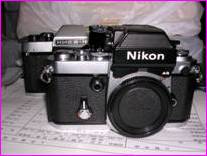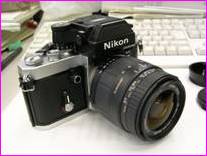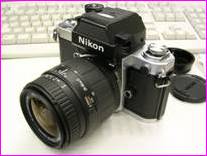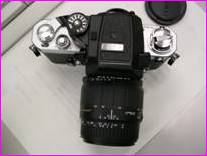|
|
|
CAMERAS IN THIS
SECTION |
|
MANUFACTURING COUNTRY |
Indonesia |
|||
|
DATE OF AVAILABILITY |
2003 March |
|||
|
SUGGESTED PRICE |
open |
|||
|
TYPE |
Lens shutter compact digital auto focus camera |
|||
|
LENS MOUNT |
Fixed Lens: 3x zoom Nikkor lens, 5.8-17.4 (equivalent to 38-115 mm in 35
film), F2.8-4.9, 7 elements in 6 groups |
|||
|
CCD |
1/2.7 inch CCD |
|||
|
RECORDING PIXELS |
3.34 megapixels (2048 x 1536) |
|||
|
MEDIA |
CompactFlash |
|||
|
LCD MONITOR |
1.5 inch TFT LCD |
|||
|
SHUTTER SPEEDS |
auto |
|||
|
BUILT-IN FLASH |
yes |
|||
|
BATTERIES |
2 x Type AA lithium batteries |
|||
|
DIMENSIONS, WEIGHT |
87.5 x 65 x 38 mm 150g (w/o batteries and media) |
|||
|
I renewed my driver's license in
October 2003. I withdrew 50000 yen from the bank for it, since I thought I would
need new glasses to pass the vision test (I wonder why I keep on renewing my
driver's license. I don't own a car. I haven't even driven for decade.). As
it turned out, new glasses were not necessary. I was left with over 40000 yen
in my pocket. My first impulse was to put it
back in the bank, but then I decided, "What the hell, let's SPEND
it." I decided to replace my
Kodak DC280J ZOOM. I wanted the Kodak DC280J ZOOM replaced,
but I didn't want to replace other accessories, such as CompactFlash and
batteries. I looked for a camera that satisfy my requirements, and came
across Nikon COOLPIX2100. It was a perfect camera for me, with similar
performance to the DC280J ZOOM, and costing only 16000 yen. But then I thought, "Why
should I buy a camera with EXACTLY same performance? That's no
progress." I checked the Nikon line-up, and
came across the 3100. It's virtually the same camera as the 2100, but with 3
megapixels instead of 2100's 2 megapixels. Cost? 25000 yen. 9000 yen difference was big, but
not too big. I purchased the camera from the same on-line shop where I bought
a notebook computer. It's serving me fine so far. |
||||
|
PROS |
1. Small
size, light weight. DC280J ZOOM cut in half. 2. Requires
only two AA batteries compared to DC280J ZOOM's four. 3. Fine
macro performance. |
|||
|
CONS |
1. Small size. Too small. There's little
space left for buttons, so Nikon decided to reduce the number of buttons to a
minimum. That's sounds good, but it's not. All buttons are multi-function; or
rather, million functions. The same button functions differently depending on
the mode set. That's normal for most digital cameras, I know, but the 3100
takes it to the extreme. I found the D100, a digital camera supposedly for
more advanced users, easier to use. Also, the small body leaves only room for
one display, which also acts as a monitor. For that reason, the 1.5 inch
monitor becomes cluttered with numerous indicators (flash, number of pictures
taken, battery status, etc.), interfering with the electronic finder. There's
an option that clears the indicators, but when you do that, you can't check
the camera set up in a single glance. 2. Battery guzzler.
The 3100 requires only two AA batteries instead of DC280J ZOOM's four. That
makes the camera lighter, but on the other hand, the batteries only seem to
last half as much. I was only able to take 80 pictures (set at minimal size)
from fully recharged batteries (more pictures can be taken when the monitor
is turned off). 3. Made in Indonesia. I've nothing
towards Indonesia; I believe it's a nice country, but my past experience
(Minolta Vectis S-1) say "buy MADE IN JAPAN". |
|||
|
With power on (Advertising
sticker still on grip) |
With power on (Advertising
sticker still on grip) |
Rear view. The
monitor is the only LCD display in this camera. I rarely use the
optical finder. |
||
|
Top view. No LCD
display. The mode dial
doesn't lock into place as solidly as I like. I often find it in the 'p'
position when I take it out of the pouch instead of the intended 'M'
position. |
Front view. To be honest, it's
not an attractive looking camera. There are cameras that are better looking.
But this is one of the very few compact cameras that enable the use of CF. |
|||
|
MANUFACTURING COUNTRY |
Japan |
||
|
DATE OF AVAILABILITY |
1982 March |
||
|
SUGGESTED PRICE |
194000 yen |
||
|
TYPE |
electronically controlled 35 mm manual focus single lens reflex |
||
|
LENS MOUNT |
Nikon F mount |
||
|
SHUTTER SPEEDS |
8 to 1/2000 seconds |
||
|
BUILT-IN FLASH |
no |
||
|
BATTERIES |
2 x LR44 |
||
|
DIMENSIONS, WEIGHT |
148.5 x 101.5 x 69 mm 760 g |
||
|
This was
the first manual focus camera I ever bought. It's also the first camera I
bought at a used camera store. Before deciding on purchasing Canon EOS7
in March 2003, the camera I seriously considered buying was Nikon F4S, sold supposedly brand
new at a used camera store (F4S
went out of production before 2000, so I have no idea how it was available
brand new). But the F4S
had a price tag of 120000 yen, which is not cheap. After contemplating for several
weeks, I finally decided to buy it. Unfortunately, another customer
beat me to it by a few minutes, and the F4S went out of my hands. So I bought
the second camera on the consideration list, EOS7. Canon EOS7
is not a bad camera. In fact, it's a perfect camera for my purposes. But it's
not a Nikon. I wanted a Nikon. Why? Canon is a fine camera manufacturer,
sure, but it also is the manufacturer of laser printers at the office. To me,
that was a no-no. So I ended up buying a Nikon F60, but it didn't
quench my thirst for another Nikon. That was when I saw a supposedly brand
new Nikon F3HP at another used camera store. It had a price tag of 130000
yen. If it was an F4S, I
would have bought it on the spot, but I didn't know much about the F3 series.
Going through a used camera catalogue, I learned that the F3 series is rated
more highly than the F4 series. My first impulse was to go out and
purchase the F3HP. What stopped me from acting on that impulse was the price.
130000 yen is no pocket change. In fact, it's a small fortune. I sat on it
for a week before going back to the used camera store, promising myself that
I would purchase it if it was still there. It was still there. After contemplating for several
minutes, I entered the camera store and purchased it. The F3HP came with the original
box, the original instruction manual, and the camera itself, brand-new (or at
least in near-mint condition) as advertised. That's pretty amazing for a
camera that went out of production several years ago. I bought the Canon EOS7
in March 2003, then bought the F60
the following month, and then the F3HP a month after that. Very few people do
crazy things like this any more. Don't you try. The F3HP is a fine camera, in a
completely league from F60
and Canon
EOS7. I hardly ever touch it, though. Later I bought the MD-4 Motor
Drive and the MK-1 Firing Rate Converter, though I have no plans to use them.
Why I bought it, I'll never know. But the F3HP looks great with them. |
|||
|
PROS |
1. Solid,
high-quality construction 2. Made in Japan. |
||
|
CONS |
1. Hefty for its size, as with all professional
cameras. 2. Out of production, and new accessories are getting
scarce. 3. Although as not as much as the F4, every buttons and
dials seems to have locking mechanisms that supposedly prevents accidents.
This makes the camera cumbersome. |
||
|
Front view, with
Sigma 28-80 lens |
Rear view |
With rear cover
open |
|
|
Front view |
Close-up |
Detail |
|
|
Detail |
Shutter dial |
Rewind knob |
|
|
Rear view |
Top view with MD-4
and MK-1 attached |
Detail of the MK-1
Firing Rate Converter |
|
|
F3HP is rather
compact, but becomes gigantic with the MD-4 Motor Drive and the MK-1 Firing Rate
Converter attached |
With MD-4 and MK-1 |
Front view, with
MD-4 and MK-1 |
|
|
Rear view with
MD-4 and MK-1 |
Side view, with
MD-4 and MK-1. Note the angled
profile of the MD-4 |
Side view, with
MD-4 and MK-1. Note the angled profile
of the MD-4 |
|
|
|
Detail of the MD-4
and MK-1 |
|
|
|
MANUFACTURING COUNTRY |
Japan |
|||
|
DATE OF AVAILABILITY |
1988 December |
|||
|
SUGGESTED PRICE |
22600 yen |
|||
|
TYPE |
motor drive integrated 35 mm auto focus single lens reflex |
|||
|
LENS MOUNT |
Nikon F mount |
|||
|
SHUTTER SPEEDS |
30 to 1/8000 seconds |
|||
|
BUILT-IN FLASH |
no |
|||
|
BATTERIES |
4 x Type AA lithium batteries |
|||
|
DIMENSIONS, WEIGHT |
168.5 x x 76.5 mm g (w/o batteries) |
|||
|
To be honest, I did not buy an F4.
I bought an F4S, then
bought a Battery Pack MB-20 (brand new) and replaced the MB-21 Multi-battery
pack and ...presto! I had an F4. That's the great thing about the F4 series.
You can upgrade or downgrade the camera simply by exchanging the battery
pack. F4 is more compact than the F4S,
but it's a big and hefty camera nonetheless. |
||||
|
PROS |
1. Solidly built, able to answer to any punishment from
professional use. 2. Superb MF capability. Some professionals regard the
F4 series as the best MF camera ever manufactured. 3. Made in Japan. |
|||
|
CONS |
1. Plastic casing. The predecessor, the F3 series, is
regarded as a classic, while the successor, the F5, is considered a
masterpiece. The F4 series is viewed inferior by F3 users, who never forgave
Nikon for giving it a plastic casing. Plastic casing, when used for certain
period, gives off a cheap sheen that is considered an undesirable type of
aging. 2. AF is a joke. The F4 series is viewed dated by F5
users because of its slow and noisy AF. It's probably passable for
non-professional use, but even entry-level cameras these days have faster,
quieter, and more accurate AF. 3. Being a professional camera, every buttons and dials
seem to have locking mechanisms that prevent accidental operation. That might
be good for professionals, but for a casual user, it makes the whole camera
cumbersome. |
|||
|
Front view. A very
wide camera |
With Sigma 28-80
lens |
With Sigma 28-80
lens |
||
|
Detail. Lots and
lots of dials. No LCD display can be found. |
F4 (left) and D100
(right) F4 body is huge (although
it might be hard to tell because the Tamron 28-105 lens on the D100 is huge) |
|||
|
MANUFACTURING COUNTRY |
Japan |
|||
|
DATE OF AVAILABILITY |
1988 December |
|||
|
SUGGESTED PRICE |
239000 yen |
|||
|
TYPE |
motor drive integrated 35 mm auto focus single lens reflex |
|||
|
LENS MOUNT |
Nikon F mount |
|||
|
SHUTTER SPEEDS |
30 to 1/8000 seconds |
|||
|
BUILT-IN FLASH |
no |
|||
|
BATTERIES |
6 x Type AA lithium batteries |
|||
|
DIMENSIONS, WEIGHT |
168.5 x 138.5 x 76.5 mm 1280 g (w/o batteries) |
|||
|
I had owned and used cameras
before, but I never considered camera as a hobby. This camera changed all
that. I've been collecting cameras ever since. I first learned of its existence
when I visited a used camera store looking for a 35mm SLR to replace the
defective APS SLR ( the Vectis S-1). It was there in the display
case, with the tag (price of 120000 yen) right in front of it claiming that
it was brand-new. The fact that it was brand-new captured my attention. After
all, why buy a risky used camera when you can buy a brand-new one at a
substantially lower price? The camera was stark contrast to
the Vectis
S-1. It was huge, with lots and lots of dials. It looked menacing.
It was black. It looked unlike any camera I had seen before.
It was beautiful. Unfortunately, 120000 yen is no
pocket change. Before heading to the bank, I had to see if it suited my
needs. I exited the store, and headed to a book shop. Finding a used camera
catalogue, I checked under F4. I learned that it was one of the first
professional cameras featuring auto focus. The catalogue stated that the AF
was dated by current standards, but since I'm no professional, there was no
need for a top-of-the-grade AF. A bit on the expensive side (very,
very expensive side, rather), but I thought it was perfect for my needs. I
began to shore up funds. It took me several weeks. I was worried that it
would be sold to someone else, but it was always there, sitting in the
display case, just waiting for me. Or so I thought. One day in March 2003, I headed to
the store with 120000 yen plus tax in my pocket. I took a look at the display
case. Of course, the F4S, with my name virtually printed on it was... ...not there. I checked the store. Another
customer was examining the F4S that I had planned to buy. I told myself to
calm down; that guy is just checking the price; he won't dare buy MY F4S. The store owner showed himself at
that moment, holding a box with "F4S" printed on the side. I had to face the fact that
someone beat me to it by about ten (perhaps five) minutes. I went to a
different camera store and bought a brand-new Canon EOS7. Canon EOS7
turned out fine, perfect for my needs. As I learned more about the F4S and
other professional Nikons, and as I also learned that the particular used
camera store in question for some reason sell camera bodies as
"brand-new" even without original boxes and manuals, I convinced
myself that it was best that I did not shelled out a fortune to purchase the
F4S. It made me become interested in
cameras nonetheless, and the first thing I did when visiting used camera
stores was to look for an F4S. F4S wasn't a hard camera to find. Unfortunately,
being a professional camera, many that I found were in poor condition. September 2003. I visited a camera
store to pick up developed photographs. The store sold new cameras and
accessories mainly, but it sold used cameras as well. I took a look at the
display case and... There is was. The F4S. A tag in front of it claimed that
it was in near mint condition, with the original box and instruction manual. It was priced at 135000 yen, not
including tax. Too expensive, was my first
thought. But being immediately after being
payday, I just happened to have the cash. After contemplating for about an
hour (the store clerks must have wondered why I was walking in and out of the
store), I decided that this was the last chance I'll ever have of getting my
hands on an F4S complete with the original box and manuals. I took the F4S home that day,
141750 yen poorer. Nikon F4 is the fourth
professional camera produced by Nikon (often referred to as the F
single-digit series), and the first in the series with auto focus integrated
from the start. In any series, odd numbered ones
are often praised, while even numbered ones are blasted (take James Bond
actors for example: Connery is considered the best, Lazenby is forgotten,
Moore revived the series, Dalton is ignored, and Brosnan revived the series
once again). F single-digit series is no exception. F4 is treated more like a
bridge between the classic F3 and the masterpiece F5, by both Nikon and its
users. |
||||
|
PROS |
1. One of the best looking cameras around. Giugiaro,
the designer who also designed the F3, is a genius. 2. Solidly built, able to answer to any punishment from
professional use. 3. Superb MF capability. Some professionals regard the
F4 series as the best MF camera ever manufactured. 4. Made in Japan. |
|||
|
CONS |
1. The battery compartment of the F4S's MB-21 battery
pack is divided into two sections, so changing batteries (six AA batteries)
is a cumbersome and tedious process. When I first took the batteries out, it
took me about an hour to put the whole thing back together. 2. Plastic casing. The predecessor, the F3 series, is
regarded as a classic, while the successor, the F5, is considered a
masterpiece. The F4 series is viewed inferior by F3 users, who never forgave
Nikon for giving it a plastic casing. Plastic casing, when used for certain
period, gives off a cheap sheen that is considered an undesirable type of
aging. 3. AF is a joke. The F4 series is viewed dated by F5
users because of its slow and noisy AF. It's probably passable for
non-professional use, but even entry-level cameras these days have faster,
quieter, and more accurate AF. 4. Being a professional camera, every buttons and dials
seem to have locking mechanisms that prevent accidental operation. That might
be good for professionals, but for a casual user, it makes the whole camera
cumbersome. |
|||
|
With Sigma 28-80
lens |
With Sigma 28-80
lens |
Rear view |
||
|
Rear cover open |
With instruction
manual |
Front view |
||
|
Front view |
Detail |
Detail |
||
|
Manual reminder,
tradition of F single-digit series |
Various dials,
which makes it look like an MF rather than an AF camera. |
|||
|
MANUFACTURING COUNTRY |
Japan |
|
|
DATE OF AVAILABILITY |
19 |
|
|
SUGGESTED PRICE |
yen |
|
|
TYPE |
motor drive integrated 35 mm auto focus single lens reflex |
|
|
LENS MOUNT |
Nikon F mount |
|
|
SHUTTER SPEEDS |
30 to 1/8000 seconds |
|
|
BUILT-IN FLASH |
no |
|
|
BATTERIES |
8 x Type AA lithium batteries |
|
|
DIMENSIONS, WEIGHT |
168.5 x x 76.5 mm g (w/o batteries) |
|
|
To be
honest, I did not buy an F4E. I bought an F4S, then bought a Battery Pack MB-23 (brand
new) and replaced the MB-21 Multi-battery pack and... presto! I had an F4E.
That's the great thing about the F4 series. You can upgrade or downgrade the
camera simply by exchanging the battery pack. In the F4S, the battery compartment was divided into
two sections, so exchanging batteries was a chore, but in the F4E, there is
only one battery compartment, so exchanging batteries is relatively easy.
Problem with the F4E is that it is huge. It's the largest commercially
available 35 mm film SLR in Nikon's history. |
||
|
PROS |
1. One of the best looking cameras around. Giugiaro,
the designer who also designed the F3, is a genius. 2. Solidly built, able to answer to any punishment from
professional use. 3. Superb MF capability. Some professionals regard the
F4 series as the best MF camera ever manufactured. 4. Made in Japan. |
|
|
CONS |
1. Plastic casing. The predecessor, the F3 series, is
regarded as a classic, while the successor, the F5, is considered a
masterpiece. The F4 series is viewed inferior by F3 users, who never forgave
Nikon for giving it a plastic casing. Plastic casing, when used for certain
period, gives off a cheap sheen that is considered an undesirable type of
aging. 2. AF is a joke. The F4 series is viewed dated by F5
users because of its slow and noisy AF. It's probably passable for
non-professional use, but even entry-level cameras these days have faster,
quieter, and more accurate AF. 3. Being a professional camera, every buttons and dials
seem to have locking mechanisms that prevent accidental operation. That might
be good for professionals, but for a casual user, it makes the whole camera
cumbersome. 4. Size. It's larger than the current flagship, the F5,
which is a huge and heavy camera. You'll need a muscle-bound assistant to lug
this around. |
|
|
Front view |
Detail |
|
|
Detail of the
MB-23 Multi-battery Pack |
F4E (left) and D100 (right) F4E body dwarfs
the D100. |
|
|
MANUFACTURING COUNTRY |
Japan |
||
|
DATE OF AVAILABILITY |
1986 April |
||
|
SUGGESTED PRICE |
89000 yen |
||
|
TYPE |
35 mm auto focus single lens reflex |
||
|
LENS MOUNT |
Nikon F mount |
||
|
SHUTTER SPEEDS |
1 to 1/2000 seconds |
||
|
BUILT-IN FLASH |
no |
||
|
BATTERIES |
4 x Type AA lithium batteries |
||
|
DIMENSIONS, WEIGHT |
148.5 x 101.5 x 54.5 mm 625 g (w/o batteries) |
||
|
I first saw this camera in a
display case of a camera store that also sold used cameras. I also saw an F401.
They were priced 12000 yen and 18000 yen, respectively. Both were in fine
condition, so I decided to buy both. In late-August 2003, I went to the
store with 30000 yen in my pocket. I checked the display case. F501 was
there. F401 was not. I was a bit surprised. I thought the F501 would be gone
first. F501 was in near mint condition.
It would have been perfect had it came with the original box and manual (I
also bought the F90S on
the same day). F501 is quite simply an F301 (the
first manual focus Nikon with plastic casing) with auto focus stuffed into
the body. For better or for worse, it showed a new direction for Nikon, a
company viewed and praised by the public as being very conservative. |
|||
|
PROS |
1. Solidly
built. 2. Nice,
square design, which some say resembles the F3. 3. Made
in Japan. |
||
|
CONS |
1. No
built-in flash. 2. AF is
slow and noisy by current standards. 3. Plastic
casing. 4. Tripod mount
is located in an awkward place, probably to accommodate the four Type AA
batteries. 5. A coin
is required to open the battery compartment at the bottom. |
||
|
Front view |
Rear view |
Rear view, with
cover open |
|
|
With Sigma 28-80 lens |
With Sigma 28-80
lens |
Front view |
|
|
Shutter button and
shutter speed controller |
Rewind knob. The
film must be rewound manually. |
Detail |
|
|
Detail. Note the
'AF' printed on the body. With AF being the standard
in cameras these days, there are very few cameras now that advertise the fact
that it has an AF. |
|||
|
MANUFACTURING COUNTRY |
Thailand |
|||
|
DATE OF AVAILABILITY |
1990 September |
|||
|
SUGGESTED PRICE |
80000 yen |
|||
|
TYPE |
motor drive and strobe integrated 35 mm auto focus single lens
reflex |
|||
|
LENS MOUNT |
Nikon F mount |
|||
|
SHUTTER SPEEDS |
30 - 1/2000 seconds |
|||
|
BUILT-IN FLASH |
yes |
|||
|
BATTERIES |
1 x CRP2DP |
|||
|
DIMENSIONS, WEIGHT |
154.5 x 100 x 66.5 mm 650 g (w/o batteries) |
|||
|
I bought this camera, along with
the F50 and F801, in a used camera store for a total of 85000 yen in July 2003.
The store claimed that this camera was new, but it only came with the
original box and no instruction manual, so it wasn't as new as the store
claimed. When I bought the F3HP at another
store, the major deciding factor was that it was brand new. It came not only
with the original box, but also with the instruction manual and an
application form for the Nikkor Club, so it was new (or at least in near-mint
condition). It seems that condition 'new' vary
from shop to shop. F601QD is camera for mid-level
users, similar to F80 in the current line up (or so I thought). |
||||
|
PROS |
1.
Built-in flash. |
|||
|
CONS |
1. Requires batteries that I have
never heard of. So I haven't turned it on yet. 2. Plastic body. 3. Not made in Japan. |
|||
|
Front view with
Sigma 28-80 lens |
Rear view |
Rear view with
cover open |
||
|
Front view |
With strobe raised |
Shutter button and
the LCD display |
||
|
Mode buttons |
Rear view |
|||
|
MANUFACTURING COUNTRY |
Japan |
||
|
DATE OF AVAILABILITY |
1991 March |
||
|
SUGGESTED PRICE |
98000 yen |
||
|
TYPE |
motor drive integrated 35 mm auto focus single lens reflex |
||
|
LENS MOUNT |
Nikon F mount |
||
|
SHUTTER SPEEDS |
|
||
|
BUILT-IN FLASH |
no |
||
|
BATTERIES |
4 x Type AA lithium batteries |
||
|
DIMENSIONS, WEIGHT |
153.5 x 102.5 x 67.5 mm 695 g (w/o batteries) |
||
|
I bought this camera, along with the
F50 and F601QD, from the same store for a total of 85000 yen in July 2003.
This one came with the body only. F801S is a camera for advanced
users, similar to F100 in the current line up (or so I thought, since it has
no built-in flash). This model was sold as N8008s in
the United States. |
|||
|
PROS |
1. Uses
Type AA batteries (four). 2. Made
in Japan. |
||
|
CONS |
1. No
built-in flash. 2. AF
nosy and slow by current standards. 3. Plastic
body. |
||
|
Front view with
Sigma 28-80 Lens |
Rear view |
Rear view with
cover open |
|
|
Front view |
Rear view.
Extremely bland |
Mode buttons |
|
|
Shutter button and
the LCD display |
Detail |
Detail |
|
|
MANUFACTURING COUNTRY |
Japan |
|||
|
DATE OF AVAILABILITY |
1997 September |
|||
|
SUGGESTED PRICE |
68000 yen |
|||
|
TYPE |
motor drive and strobe integrated 35 mm auto focus single lens
reflex |
|||
|
LENS MOUNT |
Nikon F mount |
|||
|
SHUTTER SPEEDS |
30 to 1/2000 seconds |
|||
|
BUILT-IN FLASH |
yes |
|||
|
BATTERIES |
1 x 2CR2 |
|||
|
DIMENSIONS, WEIGHT |
149 x 96 72 mm 590 g (w/o batteries) |
|||
|
I bought this camera, along with the
F801 and F601QD, from the same store for a total of 85000 yen in July 2003.
This one came with the body and the Sigma lens (28-80 F3.5-5.6 MACRO, my
first Nikon F mount lens). F50 is a camera aimed at beginners,
similar to the U series in the current line up (or so I thought). This model was sold as N50 in the
United States. |
||||
|
PROS |
1. Uses
AA batteries (four). 2. Built-in
flash. 3. Made in
Japan, which is amazing, since it's a beginner's camera. |
|||
|
CONS |
1. Plastic
body. 2. AF nosy
and slow by current standards. 3. Big and
heavy for a beginner camera by current standards. |
|||
|
Front view with
Sigma 28-80 lens |
Rear view |
Rear view with
cover open |
||
|
Front view |
With strobe raised |
With strobe raised |
||
|
Detail |
Detail |
Shutter button and
the LCD display |
||
|
Detail |
Rear detail |
|||
|
MANUFACTURING COUNTRY |
Japan |
||
|
DATE OF AVAILABILITY |
1998 August |
||
|
SUGGESTED PRICE |
62000 yen |
||
|
TYPE |
motor drive and strobe integrated 35 mm auto focus single lens
reflex |
||
|
LENS MOUNT |
Nikon F mount |
||
|
SHUTTER SPEEDS |
30 to 1/2000 seconds |
||
|
BUILT-IN FLASH |
yes |
||
|
BATTERIES |
2 x CR123A |
||
|
DIMENSIONS, WEIGHT |
148.5 x 96 x70 mm 590 g (w/o batteries) |
||
|
I bought
this camera brand new from a nation-wide camera store chain which also
operated an on-line shop, in April 2003 for 29800 yen (plus shipping and
tax). This was the first camera I bought purely for collection purposes. It's
also the first camera I bought using the net. This camera
is a personal landmark for me, opening my door to internet shopping. I bought
all new cameras (D100, COOLPIX3100,
and BC1300) from the net
since. F60 is a
camera targeted to beginners. It's a successor to F50 and the predecessor to
the current U series. This model
was sold as N60 in the United States. |
|||
|
PROS |
1. Built-in flash. 2. Made in Japan, which is amazing
since it's a beginner's camera. The U series, its successor, is manufactured
in Thailand. |
||
|
CONS |
1.
Plastic body. 2. Big
and heavy for a beginner camera by current standards. |
||
|
Front view with Sigma
28-80 lens |
Rear view |
Rear view, with
cover open |
|
|
Front view |
Front view, with
strobe raised |
Detail |
|
|
Detail |
Shutter button and
the LCD display |
Mode dial |
|
|
Rear view |
|||
|
MANUFACTURING COUNTRY |
Japan |
|||
|
DATE OF AVAILABILITY |
1994 November |
|||
|
SUGGESTED PRICE |
95000 |
|||
|
TYPE |
motor drive and strobe integrated electronically controlled
focal plane shutter 35 mm auto focus single lens reflex |
|||
|
LENS MOUNT |
Nikon F mount |
|||
|
SHUTTER SPEEDS |
30 to 1/4000 seconds |
|||
|
BUILT-IN FLASH |
yes |
|||
|
BATTERIES |
2 x CR123A lithium batteries |
|||
|
DIMENSIONS, WEIGHT |
151 x 103 x 71 mm 600 g (w/o batteries) |
|||
|
I bought this camera at an
internet auction site. The exhibitor was a camera store, and not a private owner,
so I decided it was safe. I was able to buy it for 33150 yen, in August 2003. The camera, although not
brand-new, was in near mint condition as the exhibitor had claimed. This is
amazing for a camera that went out of production long ago, and for a camera
that wasn't viewed as a 'collector's item' like the F-single digit series. The F70 is a camera aimed at
mid-level users, the predecessor to the current F80. It was introduced
supposedly to pave way for future AF Nikons, but it is generally viewed as a
failure both by Nikon and the public. The major reason was that its operation
is totally different from previous Nikons, which Nikon users (rather a
conservative lot) did not favor. One can tell that the F70 is
different from other Nikons by looking at the LCD on top. It multi-colored,
like the current G-shocks. Not even technology-crazed Canon manufactures such
cameras (as of now). This model was sold as N70 in the
United States. |
||||
|
PROS |
1. Made in Japan. 2. Built-in flash. |
|||
|
CONS |
1. Function buttons
confusing. 2. Plastic body. |
|||
|
Front view, with
Sigma 28-80 lens |
Front view, with
Sigma 28-80 lens |
Rear view, with
cover open |
||
|
Front view |
Front view, with
strobe raised |
Multi-colored LCD
display |
||
|
Function buttons |
Rear detail |
|||
|
MANUFACTURING COUNTRY |
Japan |
|||
|
DATE OF AVAILABILITY |
1993 February |
|||
|
SUGGESTED PRICE |
128000 yen |
|||
|
TYPE |
35 mm auto focus single lens reflex |
|||
|
LENS MOUNT |
Nikon F mount |
|||
|
SHUTTER SPEEDS |
30 to 1/8000 seconds |
|||
|
BUILT-IN FLASH |
no |
|||
|
BATTERIES |
4 x Type AA batteries |
|||
|
DIMENSIONS, WEIGHT |
154 x 106 x 69 mm 755 g (w/o batteries) |
|||
|
I bought this camera from a used
camera store (the same store where I bought the F3HP), in August 2003, for 41000 yen. I also
bought the F501 on the same
day (although from a different store). The camera only came with the
body. But the camera itself was in extremely good condition. F90S was aimed at advanced users.
It is the successor to the F801,
and also is the predecessor to the F100 in the current line up. This model was sold as N90S in the
United States. |
||||
|
PROS |
1. Made in
Japan. |
|||
|
CONS |
1. No built-in flash. 2. Plastic body. 3. AF slow and noisy by
current standards, but shows improvement over the F801. |
|||
|
Front view |
Rear view |
Rear view, with
cover open |
||
|
Front view, with
Sigma 28-80 lens |
Front view, with
Sigma 28-80 lens |
|||
|
Front view |
Detail |
Detail |
||
|
Shutter button and
the LCD display |
Mode buttons |
Rear view.
Extremely bland |
||
|
MANUFACTURING COUNTRY |
Japan |
|||
|
DATE OF AVAILABILITY |
2002 June |
|||
|
SUGGESTED PRICE |
300000 yen |
|||
|
TYPE |
strobe integrated auto focus digital single lens reflex |
|||
|
LENS MOUNT |
Nikon F mount |
|||
|
CCD |
23.7 x 15.6 mm CCD |
|||
|
RECORDING PIXELS |
6.1 megapixels (3026 x 2018) |
|||
|
MEDIA |
CompactFlash |
|||
|
LCD MONITOR |
1.8 inch TFT |
|||
|
SHUTTER SPEEDS |
30 to 1/4000 seconds |
|||
|
BUILT-IN FLASH |
yes |
|||
|
BATTERIES |
1 x proprietary EN-EL3 Li-ion rechargeable battery |
|||
|
DIMENSIONS, WEIGHT |
144 x 116 x 80.5 mm 700 g (w/o battery and media) |
|||
|
This was my first digital SLR. I
bought this camera from an on-line shop for 183004 yen in July 2003. Before deciding to buy this
camera, I had considered purchasing Nikon COOLPIX5700 or Canon EOS 10D. COOLPIX5700 was attractive in
terms of its price (only half that of D100), but when I went to a camera
store and tried the 5700 displayed, I found the AF slow and unreliable, and
learned that it was a battery guzzler. So out went the 5700. Canon EOS 10D, introduced few
months later than the D100, was attractive in terms of its performance
(buffer capacity), and an aluminum body. But Canon replaced the D60 with this
camera only after one year (Canon introduced the EOS KISS DIGITAL only six
months after the introduction of EOS 10D). I was afraid that I would be left
behind from Canon's rapid progress, like most other Canon users (or so I
thought). The D100, despite the plastic body
and slightly inferior performance, was attractive to me because every media
that touched the D100 praised its long battery life. Being sold for nearly a
year, I thought that glitches have been worked out. Also, it was a Nikon. I
wanted a camera that was designed to last, in terms of the product itself as
well as in terms of product line-up. The D100 is the first digital SLR
from Nikon that was not aimed for professional use (although many
professionals use it). D100 became an instant hit, out-selling its rivals,
despite being a late-comer and despite being dated compared to newer rivals. D100, when introduced, was hailed
as the smallest and the lightest digital SLR on the market, but that crown
went to Pentax *istD introduced a year later.
I later purchased the MB-D100 Multi-Function Battery Pack. It makes
the camera huge. |
||||
|
PROS |
1.
Extremely long battery life. 2. Made in
Japan. 3.
Simple-to-use interface. 4. Built-in
flash. |
|||
|
CONS |
1. Plastic body. The
surface finish is quite good, and I feel that it looks better than Canon EOS10D,
which have a metal casing. But one have to wonder about its durability. Also,
the fit of the CF slot lid of my D100 is somewhat loose. Although it's no
trouble at all for regular use, it cheapens the feel of the camera. Other
D100s I touched at shops did not have this problem. 2. Small buffer capacity (up to 6
frames only). 3. The 'dust
problem'. I knew about the dust problem before I bought it, but still, it was
quite a shock when I saw a huge amoeba-like shadow in all the images I took
in an outing. I had to rush out and purchase the AC adaptor (service center,
which happened to be close to where I live, was closed for summer holiday).
After blowing the dust off, I reattached the Tamron 28-105 lens and I haven't
detached it since. Sometimes I wonder why I bought a SLR in the first place.
Like, what's the point in buying it if you're deathly afraid of exchanging
the lens? 4. AC adaptor, a necessity for dust
cleaning, is not included in the set. 5. High price. Spend a little more
and you can buy Nikon's flagship 35mm SLR, the F5. 6. The angled CF slot. D100 is fairly
compact. And one of the consequences for that compactness is the fact that
the CF slot is slightly angled. It takes a while to get used to, and is
sometimes irritating when you're scurrying to exchange the CF. I believe that
cameras should be as compact as possible, but not at the expense of basic
ergonomics. |
|||
|
D100 with Tamron
28-105 mm |
Rear view |
|||
|
|
With strobe raised |
With strobe raised |
||
|
Front view |
Top of D100 |
Nikon Logo |
||
|
Strobe pops up
really high. |
The rear monitor |
|||
|
D100 with MB-D100
Multi-Function Battery Pack |
D100 with Zoom-Nikkor AF-S
VR 24-120 f/3.5-5.6G |
|||
|
D100 with Zoom-Nikkor
AF-S VR 24-120 f/3.5-5.6G and Nikon's
original Shooting Cart |
||||
|
|
|
|||
|
MANUFACTURING COUNTRY |
Japan |
||
|
DATE OF AVAILABILITY |
1977 July |
||
|
SUGGESTED PRICE |
126000 yen |
||
|
TYPE |
mechanically controlled 35 mm manual focus single lens reflex |
||
|
LENS MOUNT |
Nikon F mount |
||
|
SHUTTER SPEEDS |
8 to 1/2000 seconds |
||
|
BUILT-IN FLASH |
no |
||
|
BATTERIES |
2 x LR44 |
||
|
DIMENSIONS, WEIGHT |
152.5 x 102 x 64.5 mm 840 g |
||
|
Nikon F2 series was introduced as a follow-up to the legendary Nikon
F.
F2 is superior to F in almost every aspect, and even Nikon engineers admit
that F2 is the most robust in the professional 'F-single digit' series.
Following a legend is no easy task, and the F2 series, despite its
capabilities, was for a long time disregard by traditional Nikon fans as a
filler between the legendary F and the classic F3. Nikon fans changed their
opinions toward the F2 only recently, reappraising the fact that the F2
series is the last professional camera produced by Nikon that sports a
mechanically controlled shutter.
Despite the fact that the F2 Photomic AS is the top-grade camera (and
therefore the most expensive) in the F2 series, it's not a rare camera in
second-hand stores, probably because it's also the latest in the series. Avid
Nikon fans these days rate (and treasure) the F2 with the basic eye-level
finder more highly (working photomic finders are getting hard to find, and
can not be repaired any more).
Being a professional-grade camera, many second-hand F2s found are in satisfactory
condition at best. So the one I found is extremely rare for the fact that it
was in near-mint condition.
I first saw it in the shop window of a second-hand camera store where
I purchased the F3HP. It was priced at 100000 yen. Being
strapped for cash, I was not able to purchase it. I visited the store a few
weeks later, and it was gone.
I revisited the shop a few months later (February 2004), and saw the
black F2 Photomic AS, priced at 90000 yen. It was not in near-mint condition,
but it was in better than satisfactory condition, so I decided to purchase
it.
Upon entering the shop, I checked the display case for other cameras.
And there it was.
The near-mint F2 Photomic AS, priced at 100000 yen.
The camera wasn't sold; the shopkeeper had simply decided to move it
in a better display case.
Now, I had to make a decision.
Should I purchase the black Photomic AS which is rarer, but only in
better-than satisfactory condition?
Or should I purchase the silver Photomic AS which is more common, but
in near-mint condition?
The former would cost me 90000 yen. The latter would cost me 10000 yen
more.
I contemplated for a moment, and decided to go for the near-mint one.
100000 yen price tag was without the value-added tax, but when I
offered to pay in cash, the shopkeeper agreed to sell it for 100000 yen
including tax.
So now I have the F2 Photomic AS.
For obvious reasons, it's light years ahead in terms of build quality
than the Russian F mount SLR that I have, Kiev 19.
|
|||
|
PROS |
1. Solid,
high-quality construction 2. Made in Japan. 3. Although designed totally in-house and not by a
famous industrial designer like its successors, it's a handsome camera
nonetheless. |
||
|
CONS |
1. Hefty, as with all professional cameras. In terms of
dimensions and weight, it surpasses the F3HP in every way except depth. 2. Went out of production nearly 25 years ago, and
practically all accessories must be obtained second-hand. 3. Although as not as much as the F4, every buttons and
dials seems to have locking mechanisms that supposedly prevents accidents.
This makes the camera cumbersome. 4. Nikon decided not to incorporate the exposure meter
in the main body of the F2, for that reason, exposure meter had to be
incorporated in the detachable finder. This is fine for users who want
cameras with different specifications, but it makes the entire body large and
heavy. |
||
|
Front view |
Rear view |
Top view |
|
|
Bottom view Rightmost knob
opens the camera back |
With camera back
open It opens like most
cameras. For Nikon F
series, one had to detach the camera back after each film change |
Film rewind knob |
|
|
Eyepiece |
Shutter and ISO
adjust dial |
Comparison with
KIEV 19 |
|
|
With Sigma 28-80
lens |
With Sigma 28-80
lens |
With Sigma 28-80
lens |
|
